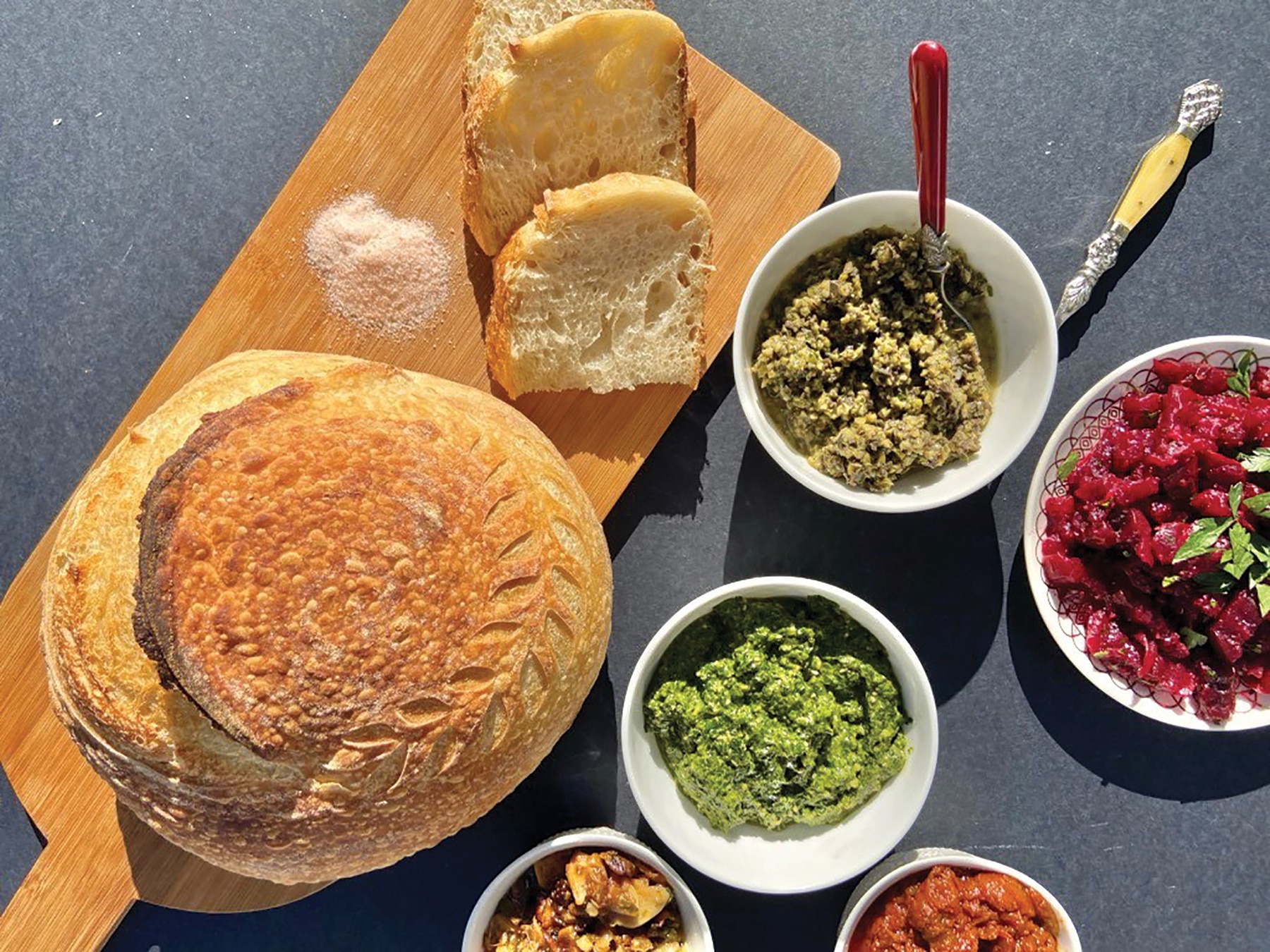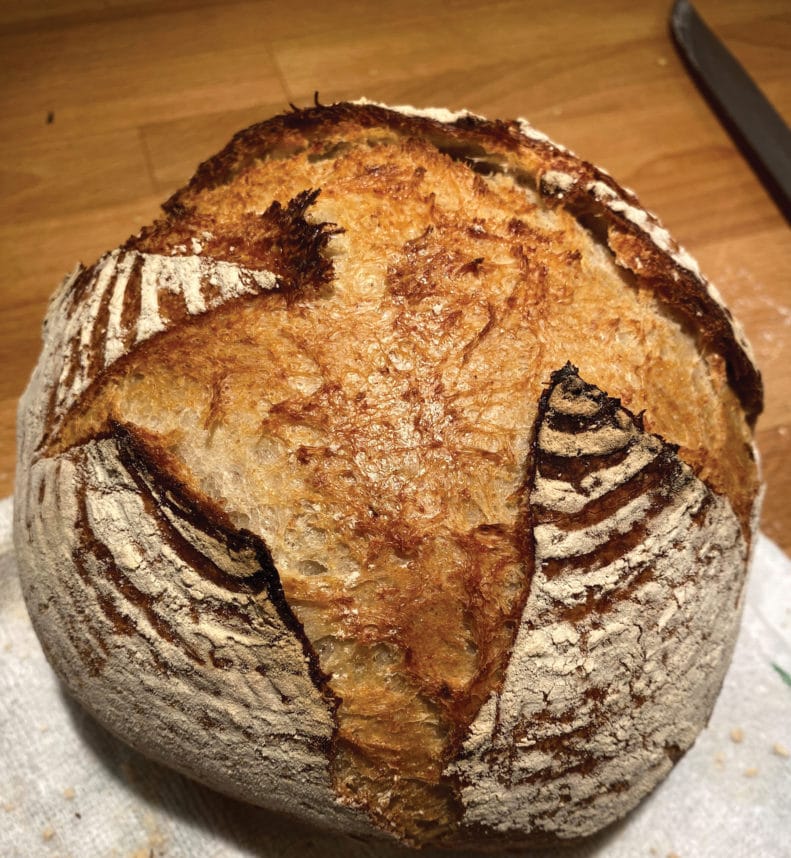
It was a cold, gray, windy day in Fog City (San Francisco). We had just disembarked from the Alcatraz Island ferry, when our Australian friend shot off like a rocket. My aunt Rebecca and I looked at each other in confusion and a bit of panic. It was the prehistoric era — before cellphones — and we had no idea how we’d find her in the jumble of tourists and vendors along Fisherman’s Wharf.
After searching a while, we found her ensconced in the warmth of the world famous Boudin Bakery, enjoying its very nonkosher clam chowder sourdough bread bowl.
While we kosher folks never will experience that sybaritic pleasure, we can indulge in a fresh loaf of sourdough bread. Sourdough bread, with its airy texture, crispy crust and tangy flavor has experienced a popular resurgence. The bubbly magic of slow fermentation increases the prebiotic and probiotic properties, which are believed to aid in digestion. During this pandemic, our Jewish community has taken advantage of the extra time at home to bake some good, old-fashioned sourdough bread.
Although my Sephardic Spice Girl partner, Rachel Sheff, bakes sourdough and makes matbucha and other fabulous dips, I prefer to buy from community vendors — Chagit’s Tasty Grains (run by Chagit Fadlon Blank) for sourdough; and Dina’s Kitchen (run by Dina Cohen Moses) for dips. I peel copious amounts of garlic, chop it and douse it in olive oil, which my entire family eats with the sourdough.
Rabbi Abraham Lieberman: Bread is known as the staff of life, and most of the world’s population consumes some form of bread daily. For the Jewish people, there is a deeper connection between bread and spirituality. Before eating bread, we wash our hands and make a bracha, then we thank HaShem “for extracting bread from the Earth.” Rabbinic sources say that we should hold our bread with all 10 fingers when making the blessing to symbolize the 10 acts of labor (plowing, planting, harvesting, threshing, grinding, kneading) before the final baked bread appears on our table. This humble act of pausing before we eat bread invokes a feeling of dependence on and gratitude to HaShem. Lechem, the Hebrew word for bread, appears in Tanakh, the Bible, around 300 times. The popular sprouted-grain Ezekiel 4:9 bread takes its inspiration from the private commandment given by HaShem to the prophet Yechezkel HaNavi to bake a specific bread (Ezekiel 4:9).
One of the most famous mitzvot revolving around bread is called “hafrashat challah,” which means separating a small piece of dough during the baking process. During the times of the Temple, this dough was given to the Kohen; today it is burned and discarded. The 13th-century “Sefer Ha’Chinuch” explains that this connects our physical world to the spiritual world. HaShem intended that this perpetual mitzvah serve as substance for the body and soul. There is also much symbolism in the kneading and shaping of dough and its development into bread with the journey of a person from birth through life.

Rachel Sheff: As a young newlywed in 1992, I went to my first challah class and learned from Debby Segura how to bake challah. I still have the booklet of recipes that she handed out that night and, over the years, I have baked hundreds of challahs for my family and friends.
Fast forward many years and Segura emailed me asking if I’d like to learn how to bake sourdough.
Would I?!
I’d been wanting to bake sourdough bread for years. I had even purchased the banneton, the special baskets used for rising the sourdough. I was never brave enough to try. This was the encouragement I needed. Segura gave me a container of her starter and emailed me the recipe. I got my ingredients together and eagerly awaited the Zoom class. I didn’t know any of the women in the group but we were all excited and eager to learn. Segura gave us step-by-step instructions and encouragement and we all felt that we were a part of something special. Baking delicious, crusty sourdough feels like an incredible achievement.
Debby Segura: It was the Saturday night after Passover and we were well into the lockdown. With nothing much going on, I figured I would make bread on Sunday. I pulled out my sourdough starter and fed it. In the morning, I woke up to the most alive, happy, comforting sight — frothy, bubbly, ready-to-leaven starter.
Over the years, many people had requested I teach a sourdough-baking class. This was the inspiration to start. I got a group together (virtually) and I conducted my first sourdough Zoom.
It was such a happy process for everyone to feed their sourdough starters at night and wake up to see their work in progress, bubbling away. We connected over mixing and kneading and baking and were rewarded by gorgeous loves of fabulous bread.
I was hooked. And so began many, many Zoom rooms filled with experienced bakers and novice cooks, young and old, locals from my congregation at Young Israel of Century City and people from all over the United States.
Chagit Fadlon Blank: Sourdough is a combination of art and science; the ingredients are simple — flour, water and salt — but the nutritional benefits are great. The long fermentation process and the lactobacilli in sourdough help make the nutrients in the bread more readily available and easily absorbed and decreases the levels of phytic acid, which interferes with the absorption of certain healthy nutrients.
Fifteen years ago, I began to experiment with sourdough and began to grow my own starter. While my initial results were edible (sort of), with time, I really got the hang of it. After my friends and neighbors tasted my sourdough breads, they started to make requests, which was how Chagit’s Tasty Grains started. Now, I bake sourdough batards in flavors like jalapeño, olive and garlic. Although the response has been phenomenal, I have received complaints that the bread is so addictive that people can’t stop eating it! (Chagit’s Tasty Grains is on Instagram and Facebook.)
Note: A kitchen scale is recommended for this recipe. Converting grams and milliliters to cups might not produce the optimum outcome.
Classic Sourdough
Inspired by Tartine’s Country Bread
For leaven:
1 heaping tablespoon sourdough starter
200 milliliters lukewarm water
100 grams bread flour
100 grams whole-wheat or white whole-wheat flour
For bread:
200 milliliters leaven
700 milliliters warm water
900 grams bread flour, plus more for dusting
100 grams whole-wheat flour, plus more for dusting
1 tablespoon fine sea salt or kosher salt
For leaven: The night before baking, discard all but 1 tablespoon of mature starter.
In one-quart glass bowl or Mason jar, mix remaining starter with 200 milliliters warm water and stir with your hand to disperse.
Add 100 grams bread flour and 100 grams wheat flour and combine well. Cover with a towel and let rest at room temperature for 12-14 hours or until aerated and puffed in appearance.
To test for readiness, drop tablespoon of leaven into bowl of room-temperature water. If it floats, it’s ready to use; If it doesn’t, allow more time to ferment.
For dough: In a large bowl, combine 200 milliliters of leaven with 700 milliliters warm water and stir to disperse. (Reserve remaining leaven for future loaves; it’s the new starter. Refrigerate in airtight container for future use up to 2 or 3 weeks. Or give a heaping tablespoon of leaven to people who want to make sourdough bread.)
Add 900 grams bread flour, 100 grams whole-wheat flour and generous tablespoon of salt to bowl and, using your hands, mix until no traces of dry flour remain. Dough will be sticky and ragged. Cover bowl with tea towel and let rest for 1 hour at room temperature.
Dip hands in water, grasp handful of dough from bottom and stretch it over top of dough. Rotate bowl in quarter turns, doing this as you go all around dough.
Cover dough again and let rest for 30 minutes. Repeat wait-and-stretch routine every 30 minutes five more times, for a total of 3 hours.
Finally, cover dough and let rest 30 minutes more. Dough should be billowy and 30% larger in volume. If not, repeat 30-minute, wait-and-stretch routine twice more.
Transfer dough to well-floured work surface, and dust top of dough with flour. Cut dough in half and shape into two loaves.
Spray two 8-inch cake pans with nonstick cooking spray and dust with flour. Place loaves in pans and cover loosely with plastic wrap.
Allow dough to almost double in size, about 2 hours. (Or let dough rise for up to 3 days in refrigerator. Allow it to return to room temperature before continuing.)
Preheat oven to 475 F.
Place rack in bottom third of oven and preheat at least 20 minutes.
Bake loaves up to 25 minutes or more, until well browned, with a little char around edges. Remove loaves from pans and cool on rack for at least 15 minutes before cutting.
Serve warm. Sourdough loaves can be double-wrapped in aluminum foil, placed in freezer bag and frozen up to one month.
Makes 2 loaves.
Debby Segura will teach a sourdough bread-making class on Zoom through the American Jewish University starting at noon Aug. 12. Rabbi Abraham Lieberman teaches Judaic studies at Shalhevet High School. He’ll teach “Jews and Bread: It’s a Classic,” a cultural history of bread from biblical times until the present, starting at 8 p.m. Aug. 2. | Password: 8sourdough
Rachel Sheff and Sharon Gomperts will answer cooking questions on Instagram at SephardicSpiceGirls or on Facebook at Sephardic Spice SEC Food. They have collaborated on Sephardic Educational Center projects and community cooking classes.























 More news and opinions than at a Shabbat dinner, right in your inbox.
More news and opinions than at a Shabbat dinner, right in your inbox.